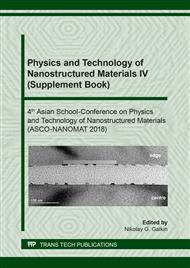p.136
p.142
p.155
p.161
p.167
p.175
p.180
p.186
p.192
Designing Microwave Filters Using Metamaterials
Abstract:
The possibility to use the split ring resonator – SRR in a microwave filter design is investigated. SRR is made from non-ferrous metals, is one of the variants of the inclusions in the metamaterial. The periodic SRR structure modifies the permittivity and permeability of the source material, to obtain a negative refractive index. These unique properties are widely used in microwave technology, because they allow to create devices with improved performance and extended functionality. Microstrip line with etched SRR on ground plane is considered. The equivalent circuit model for SRR is shown. The paper presents calculation and comparison of the return and transmission responses for SRR structure with series coupling feed lines and with parallel coupling feed lines. The basic relationships for calculating the S-parameters (the return S11(F) and transmission responses S21(F)) are given. S-parameter calculation is made. When the reflection coefficient S11(F) reaches the maximum value, and the transmission coefficient S11(F)- the minimum, the filter operates at the resonance frequency Fp. Simulation are made using the software of Microwave Office. The results are presented in graphs. The dependence of the resonant frequency of the filter from the value of the permittivity of the substrate is found. The effect of the type of metal (copper, gold, silver), from which made the SRR on the resonance frequency of the filter is defined. It is concluded that the increase in the value of the permittivity of the substrate causes a decrease in the value of the resonant frequency of the filter. While the type of metal material of the SRR, on the resonance filter properties do not have a significant influence. The research results will reduce the time spent on the design and optimization of the design parameters.
Info:
Periodical:
Pages:
167-172
Citation:
Online since:
June 2019
Authors:
Price:
Сopyright:
© 2019 Trans Tech Publications Ltd. All Rights Reserved
Share:
Citation:


